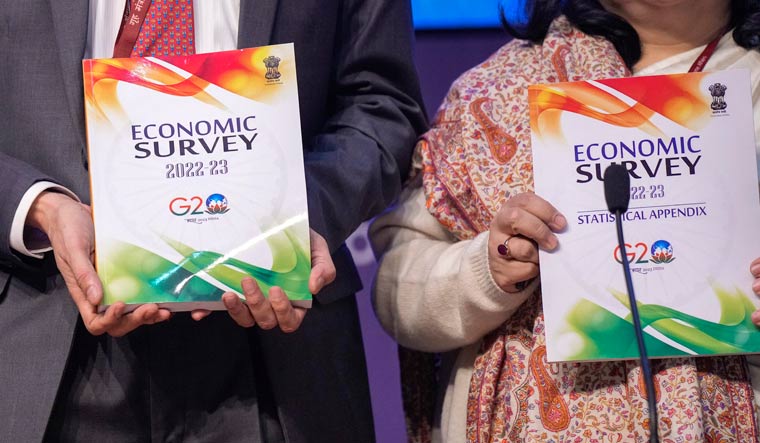India is expected to witness GDP growth of 6 to 6.8 per cent in 2023-24, depending on the trajectory of economic and political developments globally, the economic survey, tabled by Finance Minister Nirmala Sitharaman in Parliament on Tuesday, said.
The survey noted that the Indian economy has staged a full recovery in the current fiscal ahead of many other nations, positioning itself to ascend to the pre-pandemic growth path in the next financial year.
Referring to the outlook for 2023-24, the economic survey said, “India’s recovery from the pandemic was relatively quick, and growth in the upcoming year will be supported by solid domestic demand and a pickup in capital investment.”
The optimistic growth forecasts stem from a number of positives like the rebound of private consumption, boost to production activity, higher capital expenditure, near-universal vaccination, the opening of the service sector, return of migrant workers, strengthening of corporate balance sheets, well-capitalised public sector banks and credit growth to the Micro, Small, and Medium Enterprises (MSME) sector.
The Economic Survey 2022-23 projects a baseline GDP growth of 6.5 per cent in real terms in FY24. “The projection is broadly comparable to the estimates provided by multilateral agencies such as the World Bank, the IMF, and the ADB and by RBI, domestically,” officials said.
The survey stated that in real terms, the economy is expected to grow at 7 per cent for the year ending March 2023. This follows an 8.7 per cent growth in the previous financial year.
Chief Economic Advisor Anantha Nageswaran said India’s economic growth in the financial year 2023 has been principally led by private consumption and capital formation and they have helped generate employment as seen in the declining urban unemployment rate and in the faster net registration in Employee Provident Fund.
Nageswaran said the capital expenditure (Capex) of the Central government which increased by 63.4 per cent in the first eight months of FY23 was another growth driver of the Indian economy in the current year, crowding in the private Capex since the January-March quarter of 2022. “On current trend, it appears that the full year’s capital expenditure budget will be met. Going by the Capex multiplier estimated for the country, the economic output of the country is set to increase by at least four times the amount of Capex.”
Referring to the upside to India’s growth outlook, the economic survey said it stems from limited health and economic fallout from the surge in Covid-19 infections in China which translates into continued normalisation of supply chains. Even the inflationary impulses from the reopening of China’s economy turned out to be neither significant nor persistent; also the recessionary tendencies in major advanced economies triggered a cessation of monetary tightening and a return of capital flows to India amidst a stable domestic inflation rate of below 6 per cent.
The survey also pointed out that the credit growth to the Micro, Small, and Medium Enterprises (MSME) sector has been remarkably high, over 30.6 per cent on average during Jan-Nov 2022, and their recovery is evident from the amount of Goods and Services Tax (GST) they are paying.
To ease the woes of people, the survey said the MNERGA scheme has been directly providing jobs in rural areas and indirectly creating opportunities for rural households to diversify their sources of income generation. Schemes like PM-Kisan and PM Garib Kalyan Yojana have helped in ensuring food security in the country, and their impact was also endorsed by the United Nations Development Programme (UNDP). “The results of the National Family Health Survey (NFHS) also show improvement in rural welfare indicators from FY16 to FY20, covering aspects like gender, fertility rate, household amenities, and women empowerment.”
The global risk
Noting that in the current year, India has faced the challenge of reining in inflation as the strife in Europe accentuated. However, the measures taken by the government and RBI, along with the easing of global commodity prices, have finally managed to bring retail inflation below the RBI upper tolerance target in November 2022.
The survey, however, cautioned that the challenge of the depreciating rupee, although better performing than most other currencies, persists with the likelihood of further increases in policy rates by the US Fed. “The widening of the CAD may also continue as global commodity prices remain elevated and the growth momentum of the Indian economy remains strong. The loss of export stimulus is further possible as the slowing world growth and trade shrinks the global market size in the second half of the current year,” the survey said.
The global growth is forecasted to slow from 3.2 per cent in 2022 to 2.7 per cent in 2023 as per IMF’s World Economic Outlook, October 2022. A slower growth in economic output, coupled with increased uncertainty, will dampen trade growth. This is seen in the lower forecast for growth in global trade by the World Trade Organisation, from 3.5 per cent in 2022 to 1.0 per cent in 2023.
“On the external front, risks to the current account balance stem from multiple sources. While commodity prices have retreated from record highs, they are still above pre-conflict levels. Strong domestic demand amidst high commodity prices will raise India’s total import bill and contribute to unfavourable developments in the current account balance. These may be exacerbated by plateauing export growth on account of slackening global demand. Should the current account deficit widen further, the currency may come under depreciation pressure.
Entrenched inflation may prolong the tightening cycle, and therefore, borrowing costs may stay ‘higher for longer’. In such a scenario, the global economy may be characterised by low growth in FY24. However, the scenario of subdued global growth presents two silver linings – oil prices will stay low, and India’s CAD will be better than currently projected. The overall external situation will remain manageable, the survey said.




